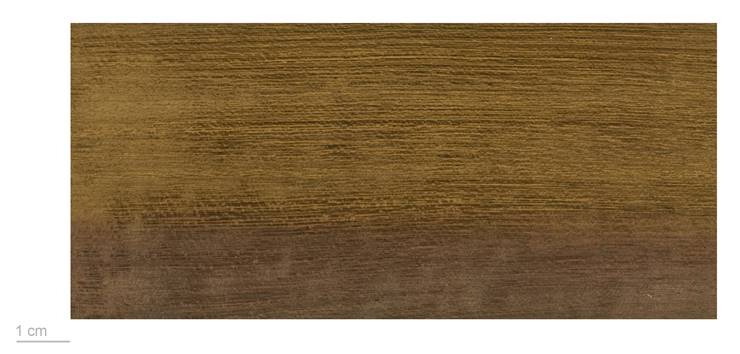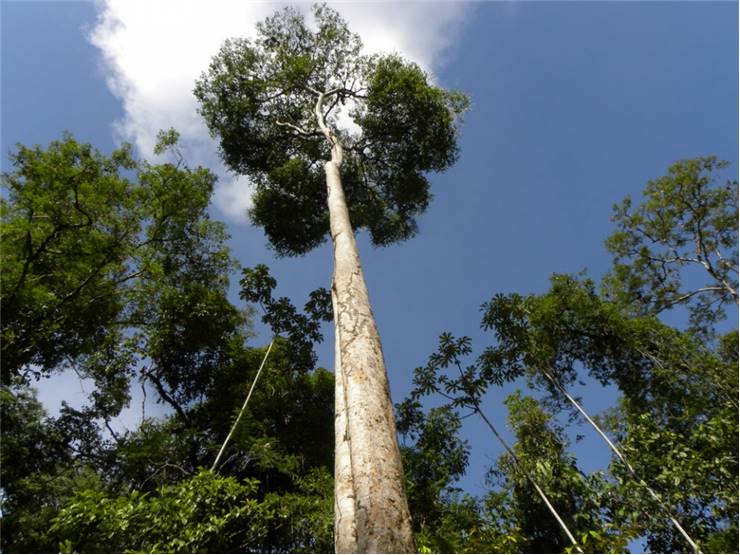Purpleheart Wood - Characteristics, Uses and Types
Purpleheart trees are part of the Peltogyne, a genus consisting of currently 23 known species of flowering medium to very large plants in the Fabaceae family. Originating from the territories of Central and South America, these tropical rainforest trees can most commonly be found in the rainforests of Brazil, Suriname, and Guyana (and also in countries such as Panama, Costa Rica, Trinidad, and the Mexican state of Guerrero) where they can grow to the impressive size ofup to 30 to 50 meters (100–170 ft) with trunk diameter of up to 1.5 meters (5 ft). Purpleheart trees are famous for having small flowers with five petals and a pod-shaped fruit that contains a single seed. The majority of all Purpleheart trees currently in existence are located in the Amazon Basin.
One of the defining characteristics of Purpleheart wood is its lumber structure's strength, density, and durability. Purpleheart is so strong it can easily be considered one of the strongest and densest trees available on the market. However, such hardiness and natural oils that are hidden inside its structure can take a toll on processing equipment, dulling the saw edges and clogging up cutting and drilling tools with its resin. But even with that hassle calculated, the amazing visual appeal and strength of Purplewood make it one of the most exotic trees originating from Central and South America.
The most popular type of Peltogyne genus is Peltogyne purpurea, commonly known as purpleheart or nazareno, famous for its bright purple heartwood with dark stripes. As of today, Purpleheart trees are not commercially cultivated, and their harvest is regulated by law in Panama and Costa Rica to prevent overexploitation. As of 2017, Purpleheart is not listed on the IUCN Red List of Threatened Species.
What is Purpleheart Wood
Purpleheart is an incredibly strong and durable type of wood, originating from the Peltogyne genus of 23 species of large trees that can be found growing natively on the territory between Mexico and Brazil. It is best known for its amazing grain pattern and unique color that can rarely be found in other wood types.
Since the qualities of this lumber have caused increased levels of lumber exploitation, several countries have imposed strong laws for cutting and processing this beneficial type of lumber that is so strong that it can be easily used for strenuous industrial construction work such as scaffolding, paneling, and flooring in areas that are regularly placed under a lot of physical stress (such as floors of heavy cargo trucks).
The internal structure of purpleheart wood consists of greyish-purple hardwood that slowly, over time, changes its color to violet purple and eventually to deep purple. This change is closely connected with the presence of ultraviolet rays which change the top layer of the wood. This color change can be reduced by coating purpleheart wood with an anti-UV coating or by sanding. Natural luster is high, with straight grain that looks visually great but can cause issues during cutting and drilling.
Some of the most significant issues during the drilling and cutting of purpleheart can be identified with plane cutting and the temperature of the tools during processing. During plane cutting, wood has a high chance of exhibiting a tear-out effect that will ruin the cut. Even more troubling, since the purpleheart is very strong and dense, it will cause the heating up of the cutting tools, which will, in turn, cause melting of the internal resin that will contaminate tools and cause various issues such as clogging. Regular cleaning of tools is needed for prolonged cutting of purpleheart.
However, the result is considered spectacular even if woodworking issues can be overcome. Purpleheart lumber is prized all around the world for its visual appeal, strength, and durability, which makes it a perfect choice for use in paneling, flooring, durable furniture (tables or tabletops) or even art pieces, and the wide variety of specialty wood items. In addition to home or common outdoor uses, purpleheart is highly praised for industrial use. It can easily be found as structural elements for columns, arches, boats, heavy constructions, or industrial flooring.
Origin
This exotic wood originates from central and South America and can be most easily found in countries such as Bolivia, Brazil, Colombia, Columbia, French Guiana, Guyana, Mexico, and Venezuela, where it is known under more than 50 types local names, including Purpleheart, Amaranth, Amarante, Guarabu, Koroboreli, Morado, Palo Morado, Pau Roxo, Purperhart, Tanzania, Violetwood, Sacka, Sackaballi, Sacka, Violet wood, Violetwood, and Dabam.
Purpleheart thrives in tropical regions and is most commonly found in the Amazon rainforest and tropical regions of Central America, where a single type of this wood (Peltogyne mexicana) can be found in the Mexican state of Guerrero.
Characteristics
- Tree Size: 100-170 ft (30-50 m) tall
- Trunk Diameter - 3-5 ft (1-1.5 m)
- Janka Hardness - 2,520 lbf (11,190 N)
- Average Dried Weight - 56 lbs/ft3 (905 kg/m3)
- Specific Gravity (Basic, 12% MC) - .76, .90
- Modulus of Rupture - 22,000 lbf/in2 (151.7 MPa)
- Elastic Modulus - 2,937,000 lbf/in2 (20.26 GPa)
- Crushing Strength - 12,140 lbf/in2 (83.7 MPa)
- Shrinkage: Radial - 3.8%, Tangential: 6.4%, Volumetric: 10.6%, T/R Ratio: 1.7
- Odor - Changes due to species. Most are odorless, while some can exhibit a mild aromatic scent.
- Workability - Mid to hard, with unique problems that arise with the presence of heat in cutting tools. That heat releases strong gummy resin that can easily clog up cutting tools if left unchecked. Grain orientation can also cause tear-outs during cutting. Since the purpleheart heartwood is dense and strong, it can easily dull cutting edges. Nailing requires pre-drilling. It can be glued well, and polishing is also easy.
- Texture - Medium and regular texture with a good level of natural luster.
- Grain - Straight and nice-looking grain, rarely irregular or with waves.
- Sustainability - Very common in tropical regions of Brazil, South, and Central America, with some countries forbidding commercial exploitation. Not listed on the IUCN Red List of Threatened Species.
- Required growth density - No particular growth requirements.
- Drying - It can dry rapidly when assisted, but air drying is slow and can introduce some cases of surface checking, case hardening, and small movement.
- Durability - Highly durable and resistant to physical damage, but with sapwood susceptible to insect attacks. This type of wood is not best suited for use in water. Lumber usually does not easily accept preservative treatments.
- Maintenance - Low
Uses
The incredible strength, durability, and visual appeal of purpleheart have made it one of the most exotic and highly praised wood types in the current commercial lumber market. Even though it remains expensive, with rising costs introduced due to the heightened government oversight of commercial exploitation, purpleheart remains in great demand.
Here are the most common use case scenarios of purpleheart wood:
- Bridge building
- Load-bearing columns
- Heavy outdoor construction work
- Dock works
- Boatbuilding
- Cladding
- Vats
- Indoor and outdoor decoration
- Stairways
- Turning
- Musical Instruments
- Furniture
- Tool handles
- Inlay
- Marquetry
- Decorative veneers
- Flooring
- Paneling
- Luxury coffins
- General carpentry
- Various specialty wood items
Types
Peltogyne genus consists of 24 accepted species of flowering plants:
- Peltogyne altissima Ducke
- Peltogyne angustiflora Ducke
- Peltogyne campestris Ducke
- Peltogyne catingae Ducke
- Peltogyne confertiflora (Hayne) Benth.
- Peltogyne discolor Vogel
- Peltogyne excelsa Ducke
- Peltogyne floribunda (Kunth) Pittier
- Peltogyne gracilipes Ducke
- Peltogyne heterophylla M.F.Silva
- Peltogyne lecointei Ducke
- Peltogyne maranhensis Ducke
- Peltogyne mattosiana Rizzini
- Peltogyne mexicana Martinez
- Peltogyne paniculata Benth.
- Peltogyne paradoxa Ducke
- Peltogyne parvifolia Benth.
- Peltogyne pauciflora Benth.
- Peltogyne prancei M.F.Silva
- Peltogyne purpurea Pittier
- Peltogyne recifensis Ducke
- Peltogyne subsessilis W.A.Rodrigues
- Peltogyne venosa (M.Vahl) Benth



